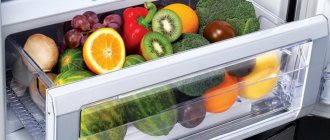A few decades ago, a refrigerator was a luxury item, but today not a single kitchen can do without it. This is a very great helper in the household, which makes life easier and safer. However, not all housewives know how to store food in the refrigerator correctly. If you do this in compliance with the requirements of SanPiN, the products will not dry out, become stale or moldy. Let's look at the basic rules for storing food in the refrigerator.
Storage in containers
The first rule to follow is to place food in containers and other closed containers. The design of the refrigeration chamber is such that moisture quickly evaporates from the products, they become overdried and shriveled quite quickly. You should leave leftover prepared dishes, various preparations, cheese, sausages, vegetables and fruits in closed containers.
Storage of food in the refrigerator will be as long as possible in glass containers. These are durable containers that are better than others at preserving the freshness of food. It is possible to use wooden and plastic containers, but if scratches, cracks or other defects appear on the plastic or wood, it is better to stop using such a container, since microbes will accumulate in places of damage.
It is not recommended to use cling film for packaging because condensation forms in it, which promotes the formation of bacteria and mold. If there are not enough containers to accommodate all the food, you can use parchment paper. It allows air to circulate, which prevents condensation from forming. Foil is suitable for ready-made dishes - this material retains moisture and does not allow oxygen to pass through, which makes storage in the refrigerator longer.
Correct placement of products
This may be a discovery for some, but each shelf in the refrigerator has its own temperature, which means that only certain foods can be stored on it.
Let's consider the correct storage of food in the refrigerator depending on the temperature:
- The door is the warmest place in the refrigerator. Oils, hard cheeses, various sauces and drinks with a long shelf life are stored here. The door shelves are not suitable for storing perishable food items.
- Most refrigerators have two built-in containers designed for vegetables and fruits. To prolong the freshness of these products, you should place antibacterial mats on the bottom of the containers. You also need to remember that before placing fruits and vegetables in containers, you should wash them well. It is better to store berries and fruits separately from vegetables and herbs, so as not to provoke rapid rotting of both.
- Fresh meat stores well in the refrigerator on the lower shelves, where the temperature is usually lowest. But it is important to remember that raw meat and fish can be stored for no longer than 2 days, even in the refrigerator. If you plan for longer storage, it is better to put fresh meat and fish in the freezer.
- Prepared dishes should be placed on the middle shelves, covering each dish with a lid. It is important to avoid the “neighborhood” of raw products and cooked dishes, since various bacteria can get from the surface of raw products into prepared dishes, and then into the body.
- It is not advisable to store canned food in the refrigerator. They retain freshness perfectly at room temperature, and the presence of a large number of cans in the refrigerator disrupts normal air circulation, which has a negative effect on the freshness of other products. But if we are talking about open canned food, then they must be stored only at low temperatures and no longer than 1-2 days.
- For milk, kefir and other dairy products, the topmost shelf is suitable, where the optimal temperature is ensured. But if you wish, you can store prepared meats, smoked meats and cheeses here, putting everything in separate containers.
- If you need to properly place cooked dishes in large pans, it is better to place them on the bottom shelf. Here they will stay fresh longer, and the bottom shelf will best withstand the weight of such containers.
Important tip! The arrangement of products in the refrigerator should be such that they do not touch each other. The proximity of fresh meat and fish, vegetables and fruits, cooked and raw foods, oils and aromatic spices is especially dangerous.
In which departments what products are stored?
In addition to packaging, an important role in storing food in the refrigerator is played by their location on the shelves. It is wrong to place goods in a chaotic order.
How to properly store food in the refrigerator
The average temperature in the refrigerator is about +5 degrees. The shelf under the freezer is the coldest, and the bottom drawers are the warmest.
General compartment at the top
The temperature on the top shelf can vary from +3 to -1 degrees. Therefore, this compartment of the refrigerator is considered an ideal place to store products with a short shelf life.
These include dairy or meat products, as well as seafood and eggs.
Refrigerator manufacturers still make special trays for eggs in the doors of the device. However, the door is not suitable for storing them.
When you open the refrigerator, warm air hits the eggs, and as a result, their shelf life decreases. In addition, the risk of salmonellosis infection increases. It is best to store them in cardboard or plastic containers after purchase.
Dairy
How to store dairy products
The shelf life of dairy products depends on the category and packaging. Heat-treated products can be stored longer than fresh ones.
Tips for storing selected dairy products:
- Cheeses dry out very quickly. It is recommended to pack them in foil, parchment paper or a glass container. The trick is a sugar cube. If you put it in a package with cheese, it will absorb excess moisture and extend its freshness for up to two weeks.
- Cottage cheese is sold in different packages. If you buy it by weight at home, you need to transfer it to a glass container or vacuum packaging.
- Store butter in a glass butter dish. A small portion is cut off from a large piece for daily use, and the rest is stored in the freezer.
- It is better to pour store-bought milk into glass bottles with a lid at home.
Meat products
Meat and meat products should be stored on the top shelf. A fresh piece of meat can be kept in the refrigerator for no more than two days.
It is better to immediately place the prepared minced meat in the freezer or prepare some dish from it. Pathogenic microbes multiply very quickly in it.
The storage periods and conditions for meat products vary by type:
- Sausages. In the manufacturer's packaging – no more than 3 days.
- Sausages. In a container or manufacturer's packaging – no more than 3 days.
- Semi-finished meat products. In glass containers – no more than 2 days;
- Fresh meat. In a ventilated container - no more than a day;
- Boiled meat. In a glass container - no more than 2 ducks.
Seafood
Seafood is the most perishable. Fresh fish must be cleaned and washed, and then placed in a glass container with a lid and stored for no more than a day.
Salted or smoked fish should be placed in foil or cling film. It can be stored for up to 3 days.
Fresh seafood can be stored in the refrigerator for no more than 7 hours. Canned fish in original packaging can be stored for up to six months.
Second and third shelves
Sausages and smoked meats must be placed in a container or covered with cling film.
The middle shelves of the refrigerator have an average temperature. You can put the following food on them:
- Sausages and smoked meats. They must be placed in a container or covered with cling film to prevent them from drying out.
- Confectionery. Cake, pie, sweets with cream and other products must be packed in a container or film.
- Ready meals. They can be stored directly in pans or in glass containers.
- Salad. The preparations must be without dressing and in glass containers.
- Canned food after opening the original packaging. From iron cans they need to be transferred to glass containers.
- Bottles with drinks.
Products with a short shelf life
Ready-made meals have a short shelf life. Their maximum shelf life is two days. After this, bacteria begin to multiply in them, and the products lose their nutritional value.
Any dishes - from salads to baked goods - must be packaged in appropriate containers and tightly closed.
Zero compartment or bottom drawers
The lower compartment of the refrigerator has special drawers. The air temperature here is the highest. This section is suitable for vegetables and fruits.
Vegetables, fruits, berries
Vegetables and fruits should be stored separately (one box for vegetables, the other for fruits)
Recommendations for storing vegetables and fruits:
- Vegetables and fruits should be stored separately (one box for vegetables, the other for fruits).
- It is not recommended to store fruits in plastic bags or at least untie them. Moisture accumulates in a tightly tied bag, and the fruits begin to rot quickly.
- It is better to store vegetables and fruits in bulk.
- Place the berries in a container in the refrigerator.
- Greens must be placed in a jar of water. This way it will retain its freshness and appearance longer.
- If you find one rotten vegetable or fruit, remove it immediately. A spoiled fruit releases gases that will cause the rest to rot.
Door
The refrigerator door is a place with variable temperatures. When you open the device, warm air hits the door directly and the food standing on it heats up. It is not recommended to store eggs and dairy products here.
The most suitable for the refrigerator door are various sauces, ketchups, juices or medicines.
Freezer
The coldest area in the refrigerator is the freezer. The temperature here is about -18 degrees. In such conditions, products are preserved for a longer period.
Freezer storage instructions:
- Peel meat, fish products, as well as vegetables or berries in advance and divide into portions.
- Give minced meat pieces a flat shape (it takes up less space and defrosts faster).
- Pack all food in plastic bags or containers.
- Freeze only once.
- Sign packages. This will help you find out how long a particular product can be stored.
What should not be stored in the refrigerator
Along with the answer to the question of how to properly store food in the refrigerator, it should be noted which products are not advisable to leave in it for storage:
- Bread . It is better to keep the bread on the table, covered with a towel, or in a bread bin, but under no circumstances in the refrigerator, as here it will quickly become hard and damp. It is advisable to buy the amount of bread that will be consumed within 4 days, so that you don’t have to think about how to keep it fresh.
- Coffee . Surprisingly, in some families it is customary to put coffee in the refrigerator. But this method will only be relevant to neutralize bad odors, and if the goal is to preserve the properties of bean, ground or instant coffee, it is better to leave it in a dry, dark place, having first poured it into sealed containers.
- Onion. Bulbs are poorly stored in conditions of high humidity, which are typical of the refrigerator compartment. It is better to store onions in a cool place, for example, on a balcony.
- Olive oil . It is this type of vegetable oil that must be kept at a special temperature - from +12 to +16 degrees. Improper storage can lead to separation of the oil and loss of its taste and beneficial properties.
- Honey _ If honey is stored in a closed container at room temperature in a dark place, it will retain all its beneficial and tasteful qualities for several years. But once you put honey in the refrigerator, it will quickly crystallize and its taste will become less pronounced.
- Chocolate . Storing chocolate at low temperatures causes a white coating to appear on its surface. This occurs due to freezing of moisture and the appearance of sugar crystals, which negatively affects the presentation of chocolate and its taste.
- Garlic . Surprisingly, garlic sprouts best in the cold. If there is no goal to obtain seedlings, it is better to leave the garlic for storage in another place, for example, on the balcony or in closed kitchen drawers away from the stove, sink and radiator.
- Potato . It is customary to keep this vegetable in a cool, dark place, but not at such a low temperature. The best option would be a cellar or balcony, where the potatoes will remain fresh for a long time, and their tubers will not change their structure and taste.
- Avocado . Ripe avocados can indeed be stored in the refrigerator, but if they are not ripe, then at room temperature this will happen faster and better.
Good to know! Cut avocados should be stored in the refrigerator, wrapped in cling film or placed in an airtight container. At room conditions it will quickly deteriorate.
- Tomatoes. Tomatoes are quite fastidious to store. This vegetable does not like sub-zero temperatures, as it quickly softens and loses its taste and aroma. Therefore, it is better to store tomatoes in a cool, but not too cold place.
Useful tips
- Additional shelves and trays for eggs are another idea of marketers. Researchers at the University of Bristol have shown that placing eggs on the refrigerator door causes them to go rotten faster, as there is a temperature difference when opening and closing the door.
- All exotic fruits and vegetables are not adapted to low temperatures; they do not tolerate being placed in the refrigerator. Bananas, peaches, kiwis, oranges and other “exotics” feel much better at room temperature.
- Do not confuse canned food and preserves. If canned food is always sterilized and does not require sub-zero temperatures, then preserved food does not undergo such treatment. To maintain the freshness of preserves, you need to keep them at least at zero temperature.
- If the housewife constantly wonders how to store food in the refrigerator that remains “piece by piece” so that it does not get lost, then it is worth having a convenient container for such leftovers. A piece of cheese, sausage, cucumber or other products will always be in a visible place and “remind” you of yourself.
- Every housewife should know not only how to properly place food in the refrigerator, but also how long they can be stored. This is the basis for preventing food poisoning. The shelf life of frequently consumed products is presented in the table:
What foods should not be placed in the refrigerator?
Most store-bought foods are placed in the refrigerator.
However, some of them do not need cool conditions and can be stored in a closet:
- exotic fruits from tropical countries;
- fruits – apple, banana, pear, tangerine;
- vegetables - potatoes, onions, zucchini, pumpkin, garlic;
- olive oil;
- conservation;
- juice in a tetra pack;
- nuts;
- honey;
- chocolate;
- jam;
- bread.
Undesirable neighborhood
In addition to the mandatory packaging of all products in the refrigerator, it is important to respect the proximity. Certain products can negatively affect the freshness of neighbors.
It is not recommended to store together:
- raw meat and fish along with prepared meals;
- dairy products and smoked products;
- sausages and fruits;
- fruits and vegetables;
- spices and oils;
- prepared dishes and eggs.











